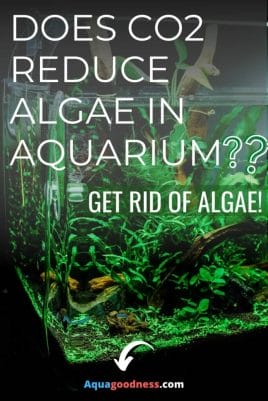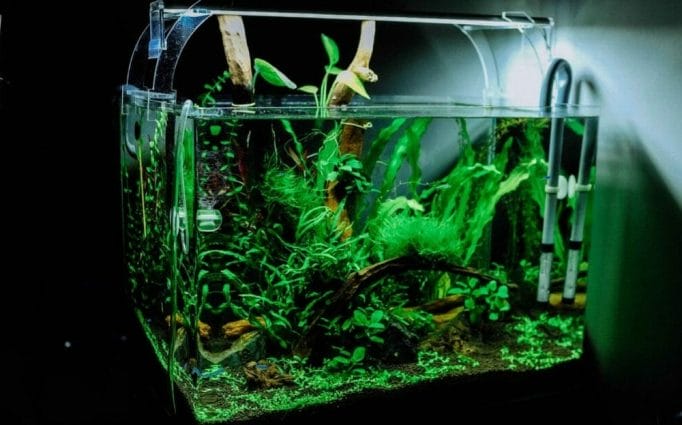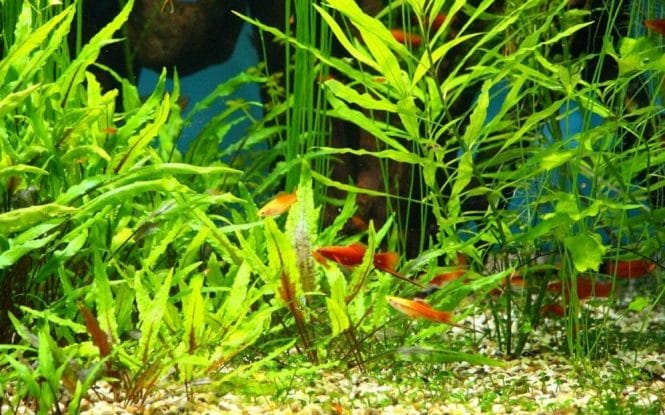You may have heard from your expert aquarium friends that CO2 is the answer for that stinky algae in your aquarium.
Or you may have read several times on various aquarium forums that CO2 can help to reduce algae in the aquarium.
But is it really true?
Let’s find out in this article.
If you are providing too much light to your aquarium plants but providing a little quantity of nutrients and no CO2 or little CO2 then, in this case, increasing CO2 or providing CO2 can help to reduce algae in your aquarium.

Table of Contents
When does adding CO2 can help to reduce algae in an aquarium?
Algae bloom occurs when there is an imbalance in your planted aquarium.
What I mean by imbalance is that the plants are not getting all the elements i.e. light, CO2, and nutrients in a balanced quantity.
Plant’s ability to absorb CO2 and nutrients depends on the light it gets.
For example, if you are providing too much light (this could be more hours light per day than necessary or more light intensity than necessary) to your aquarium plants. And you are not providing enough nutrients and CO2 then the plants will suffer from deficiencies and start to melt and algae bloom occurs.
Your aquarium can also get more light than necessary if it is directly exposed to the sunlight.
Besides, exposing the aquarium to direct sunlight can cause other issues.
So, in this case, you have two options to correct the imbalance and reduce algae in your aquarium.
1. Reduce light


You can reduce the lighting hours or the intensity of the light to reduce the algae in your tank.
Usually, for most planted tanks 8 hours of light is sufficient.
If your aquarium is directly exposed to sunlight, then you can put your aquarium to a different place away from sunlight.
When you do these things, there will be no excess light for algae to take advantage and grow in your aquarium.
If you are having a hard time maintaining consistency in the hours of light you need to provide on a daily basis, then you can use a timer.
The timer will automatically turn on and off the light every day. This makes sure that you are aquarium plants are getting the light consistently every day.
The potential problem with this approach could be that, though you will get rid of algae in your aquarium plants will not grow faster and denser.
Besides, some red aquarium plants require highlighting environment for the red coloration. So if you have some red plans then they may not show red coloration under low light.
Also, if you have light-demanding plants, then they will not do their best under low light.
Overall, your planted tank may not look its best if you reduce the light in your tank.
So what’s the solution.
This brings us to our second option.
2. Add or increase CO2 and nutrients

Plants’ ability to absorb nutrients and CO2 depends on the light it gets.
If your aquarium plants are getting too much light, then they will also require more nutrients and CO2 concentration.
If you are not providing enough nutrients and CO2 concentration to the plants, then the plants will suffer from deficiencies. And they will start melting and algae bloom will occur.
So if you increase CO2 concentration and provide more nutrients by increasing fertilizer dosage then the plants will not suffer from deficiencies. And this also helps to reduce algae in your aquarium.
Do Aquarium Plants Need CO2? (Can you keep them without co2)
How much fertilizer dosage should I increase in my aquarium tank?
If you are not already providing fertilizers to your aquarium plants, then you should start with All-in-One fertilizer like Seachem Flourish. It contains all the essential nutrients that plants need. You can check it out at Amazon here.
And start with the dose mentioned on the label of the fertilizer bottle.
After a while, you can gradually increase the doses if you like.
However, after increasing the dose of fertilizers if you notice algae bloom then you should reduce the dose.
7 Best Aquarium Plants That Don’t Need Fertilizers
Are Aquarium Plant Fertilizers Safe For Fish? (Best fish safe fertilizers)
How much CO2 injection should I increase in my aquarium?
If you are not already injecting CO2 in your aquarium, then you set up a CO2 system and start injecting CO2 in the tank.
Along with a CO2 system, also get a CO2 drop checker.
CO2 checker is a very handy device that tells you if you are providing too little CO2 or too much CO2 or you are providing correct CO2 to your aquarium plants.
This device contains a liquid that turns blue when you are providing too little CO2.
It turns yellow if you are providing too much CO2. And it turns green if you are providing the correct level of CO2 to your aquarium plants.
Usually, CO2 between 1 to 3 bubbles per second is sufficient to get the green coloration in the drop checker.
You can check the bubbles in your bubble counter that comes with the CO2 system.
Do Aquarium Plants Reduce Algae? (5 Best plants to reduce algae)
How to reduce algae in other situations?

Besides, the situation mentioned above, there can be several scenarios when algae can grow in your tank.
And in each scenario, you will have to take different measure to reduce algae in your aquarium.
Now I am going to list out these other scenarios. And I’ll also tell you what steps you can take to reduce algae in those cases.
1. Algae growing in new fish tank setup
It is very common to see algae bloom in new fish tank set-ups of 2 to 3 months. This algae is called brown algae or diatom algae.
The algae bloom occurs in new setups because the new fish tanks are not established i.e. they don’t have a sufficient amount of beneficial bacteria present in the tank to convert ammonia produced by fish poop into to nitrate or nitrites.
And when there is high ammonia level in the tank, algae will take advantage of the ammonia and grow in the tank.
So the solution for this problem is you should do about 30% to 50% water change of your tank every week when you set up a new tank.
When you do the water change, you’re basically diluting the ammonia in the tank.
And when you do this enough times i.e. until the sufficient amount of beneficial bacteria forms in your tank, then basically you’re not giving algae a chance to take advantage of ammonia.
Once your aquarium becomes established i.e. it contains sufficient colonies of beneficial bacteria, then you don’t need to do 30% to 50% water change.
Doing water change of 10% to 20% is sufficient.
If you have live aquarium plants in your tank, then the process of forming the beneficial bacteria speeds up because the beneficial bacteria requires a lot of oxygen to replicate. And live aquarium plants provide oxygen to them in the aquarium.
Besides, there’re some other ways to deal with Diatom algae. You can find those in this video.
Do Aquarium Plants Absorb Ammonia? (5 best plants to reduce ammonia in a fish tank)
2. Poor aquarium maintenance
Keeping up with the weekly and monthly maintenance of the aquarium is very important for a healthy ecosystem in the aquarium and to keep algae in control in the aquarium.
When you are not carrying out the weekly and monthly maintenance of the aquarium regularly, then this causes harmful organic impurities like ammonia to build up in the tank.
Algae can take advantage of the ammonia and start growing in the aquarium.
So there are a few things you’ve to do regularly to keep your tank clean.
- You should do the weekly water change regularly. (30 to 50% water change if you have a new set up. 10 to 20% if you have an established tank)
- So you should vacuum the substrate of your aquarium to remove impurities from your tank on a weekly basis.
- You should immediately remove the eaten food after feeding the fish in your tank.
- You should also change the filter media of the filter of your tank on a regular basis.
- The dead leaves of the aquarium plants decays and produce ammonia in the aquarium. So you should regularly trim your aquarium plants and remove dead leaves, this will also encourage new growth.
20 Tips to Maintain a Healthy Aquarium
3. Poor water circulation in aquarium
Poor water circulation in an aquarium is another very common cause of algae bloom in planted tanks.
Even if you are providing sufficient nutrients and CO2 to your aquarium plants, you can’t guarantee that they are getting all the nutrients and CO2 you’re providing to them.
If your aquarium doesn’t have good water circulation, then the co2 and the nutrients don’t reach all the plants in your tank or all the parts of the plants. So they’ll not absorb and take advantage of all the nutrients and CO2 you’re providing to them.
Here, algae can take advantage of the CO2 and nutrients and grow in your aquarium.
So what’s the solution?
The solution in to increase water circulation!
For optimum water circulation, your aquarium filter’s flow rate or your power head’s flow rate should be around 10 times the volume of your aquarium.
For example, if you have a 55 gallon aquarium then the flow rate of the filter of your aquarium or the flow rate of the power head or the combination of both should have a flow rate of 550 gallons water per hour.
15 Things You Must Know Before Buying Your First Aquarium
4. Poor surface agitation
Poor surface agitation doesn’t directly causes algae bloom in your aquarium. However, it can indirectly cause algae bloom in your tank.
Now let me explain what I mean by that.
Basically, surface agitation is necessary in an aquarium because it helps to oxygenate the tank as gas exchange happens on the surface of the water of your tank.
So when there is not sufficient surface agitation, then this causes a lack of oxygen in the fish tank.
Now aquarium plants take Carbon dioxide in when they are getting light and exhale out oxygen.
But when the plants are not getting light, this process reverses. And they start taking in oxygen and exhaling CO2.
At the same time the fish in your tank and the beneficial bacteria in your tank which are responsible for converting ammonia into nitrate and nitrite also requires oxygen.
So at the night time when the lights are off, plant started to absorb oxygen. Now at this time, the fish, the plants, and beneficial bacteria start to compete for oxygen in the tank which creates oxygen deficiency in the tank.
And during this period, the beneficial bacteria can die off due to lack of oxygen in the tank.
And this can increase ammonia in the tank, which causes algae bloom in the aquarium.
Overall, lack of surface agitation can cause a lack of oxygen in the aquarium > which can cause the beneficial bacteria to die off > which increases ammonia level in the aquarium > which causes algae bloom in the tank.
Besides, surface agitation also helps to prevent Surface Scum from forming on the surface of the water of your aquarium.
Surface scum is basically an oily film that forms on the surface of the water of your aquarium.
So now what’s the solution.
The solution is to increase surface agitation.
To increase the surface agitation, you should introduce an air pump in your tank.
There are a lot of air pumps available in the market. The problem with most of them is either they’re not reliable or they make too much noise. However, I found that Tetra whisper is one of the most reliable air pumps and it is not noisy. You can check its price at Amazon here.
However, too much surface agitation is also a bad thing. Because if you’re injecting CO2 in your tank, then CO2 gas can come out of the aquarium because of too much surface agitation.
So you should keep the air pump on only at night when the lights are off. And you’re not providing CO2 to the aquarium plants.
6 Best Aquarium Plants to Prevent Algae (Detailed information)
Conclusion
Overall, adding CO2 or increasing CO2 in the aquarium can help to reduce algae in your aquarium if you’re providing too much light to your aquarium plants.
I hope you found this article helpful.
If you do, please share it.
Happy aquascaping!
Image credit: